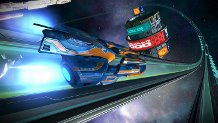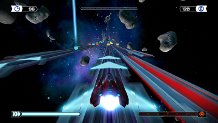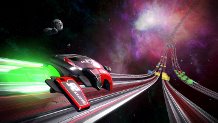Liverpool Sound and Vision Rating 9/10
Switch Galaxy Ultra is a reflex based racing game available as a download from the PlayStation Store for the PS4 and PS Vita. Switch Galaxy Ultra originated as an iOS game called Switch in 2011 which was improved before releasing it as a PlayStation Mobile game under the name Switch Galaxy in 2013 ahead of the most enhanced and refined version of Switch in the form of Switch Galaxy Ultra on PS4 and PS Vita. Atomicom has PlayStation history running through its veins as their managing director is Gary Nichols who began his career in the videogame industry at the legendary Psygnosis who developed such amazing PS1 classics such as Colony Wars, Destruction Derby and WipEout. The Liverpool based indie developer Atomicom is active in their charitable work as the game has downloadable content called the Charity Pack which supports Caudwell Children with the full proceeds of that particular pack being donated to support poor, sick and disabled children which is certainly a nice way of giving back to the community and those less fortunate.
The story revolves around one of Dakur’s best pilots Vince Vance as he carries out his mission as instructed by the Head of Dakur Technology Amur Ness to find as much Tantalum as possible to use in their research of their new jump drive. The story is told through a series of seven stylish and well drawn comic book strips that can be revisited at any given time via the Comic Episodes and were designed by Darren Douglas who was actually the original concept artist for WipEout. The comic book strips really illustrate a unique and humorous insight into the life of Vince Vance as he lives and gambles dangerously, while also providing a real sense of scale to the galaxy, planets and locations the events unfold on.
There are two game modes, the story mode and survival mode with the story mode containing a progressive tale that is in parallel with the progression made through each of the 55 tracks. The survival mode sees players attempting to grasp a single chance to cover as much distance as possible by not hitting any barriers that are initially relatively easy to avoid, but are noticeably more strategically positioned to make it as deliberately challenging the further progression into the game is made, while trying to break individual personal best records in order to earn credits.
Continued acceleration is vital if players are to complete the track as quickly as possible as they will need to avoid red areas of each lane of the track that have broken off due to asteroids having previously collided with those particular areas of the track, although rather than destroying the ship; it will slow it down, so while it would not be the end of the world if a player were to drive over a red broken area of the track, it would slow the pace and potentially prevent gold reward time from being awarded. Another potential hazard are the red, blue, yellow and green barriers that are designed to tax the highways as ships pass through them, although as players race a Dakur ship it just slows the ship down instead if players were to pass through any of them, but instead of taxing as credits it will charge in Tantalum, therefore it is imperative to make sure to switch between the multiple lanes available in order to avoid such hazards as broken lanes and barriers as players look to keep a consistent pace, whist also needing to be weary of an entire host of other hazards that are gradually introduced as progression is made.
However, introduced relatively early on are barrier passes that can be purchased for 25 credits per barrier pass in each of the 4 available barrier colours and there are scenarios in which a barrier pass towards the start of a track will be needed as all of the lanes will be blocked with barriers at the same point providing no way through by skilfully evading them, although players can also collect barrier passes at times on some of the tracks which will allow them to bypass 3 barriers of the same colour. Boosting is also an important part of the speed as players will need to drive over the blue boost pads in order to charge the boost before being able to use any of it to increase the speed of the ship beyond that of its maximum speed, while another important element is upgrading the Galaxy Net computer to provide vital information for each track which is a great design choice as it gives a greater sense of preparation before starting the track in exchange for credits.
Players will approach a wormhole towards the end of a track; during the wormhole orbs of light called Tantalum will be found (which is a currency that allows players to enter new areas of the galaxy). Quick progression through a track will result in rewards from representatives of companies such as Dakur Technology providing extra credits for achieving the gold reward time, although credits can be collected on some tracks and used as currency towards purchasing upgrades. Ship upgrades are very important to progress and improve the performance by having the best ship available with everything needed from Dakur Technologies shipyard including multiple upgrades available to the ship’s boost, acceleration, dexterity, density and shield for a price starting at 200 credits for the initial upgrades, while there are also a range of liveries available for 300 credits each and unlockable ships.
The ship design is absolutely perfect as it paints the picture of piloting a futuristic vehicle that is capable of extremely fast speeds and boosting to become even faster as a trail of light is viewable from the rear of the ship to emphasise the feeling of genuine speed and a form of exhaust for futuristic technology.
The track design is very imaginative as they differ in the proximity of their hazards from track to track, while the futuristic sci-fi outer space backgrounds set the scene with such a vivid visualization of cities by WipEout co-creator Jim Bowers.
Switch Galaxy Ultra supports the share feature that allows players to upload a video clip or a screen shot to Facebook or Twitter and broadcast live gameplay footage via Twitch or Ustream as the game is being experienced with a simple tap of the share button and selecting the option of choice. The PS4’s hard-drive continuously stores the most recent fifteen minutes of gameplay footage, so players still have the chance to decide if they would like to share something amazing a few minutes after it has taken place. The share feature is a next-gen revolution that has only improved with the further customisation provided by the Share Factory app that allows commentary, music, themes, stickers, effects, text, picture-in-picture video between your game footage and your reaction from the PlayStation Camera and much more besides, which will only continue to prosper and flourish as it matures with additional features and further experimentation in the future. The Share Play feature provides a platform for a gamer that does not own Switch Galaxy Ultra to take control once started and invited that person to play, although it only lasts for one hour; it is a great service as it effectively presents a one hour demo of the game to anyone invited who does not own it, while being an excellent sociable feature too.
Switch Galaxy Ultra supports cross-buy and cross-save between the PS4 and Vita. Cross-buy presents a superb amount of value as it means that players will be purchasing the PS4 and Vita versions of the game with just a single purchase. The cross-save functionality allows players to sync the progression of the save file from their Vita to PS4 and vice versa, so players can start playing the game on their Vita on the way to and from work, sync the save game when they return home and then resume where they left off by loading the save game and continuing via the PS4 version. The cross-save feature is made possible by uploading the save file to the cloud on one console and downloading it from the other console.
The downloadable content is cross-buy with Charity Pack 1 only costing £3.99 and features an exclusive ship; 15 levels; 2 challenges and 4 licensed music tracks per music artist including Nero, Chase and Status, Modestep and Kove, while Music Pack 1 costs £2.99 and provides further licensed music with 4 tracks per artist from the same music artists as found in Charity Pack 1. The Charity Pack 1 downloadable content supports Caudwell Children as every penny of the £3.99 is charitably donated to Caudwell Children, while Music Pack 1 helps to support the developer with more downloadable content planned for release in the future.
The controls are well mapped to the DualShock 4 controller with the control scheme consisting of pressing R1, pressing right on the d-pad or moving the left analogue stick to the right to switch to a lane that is to the right of the ship; pressing L1, pressing left on the d-pad or moving the left analogue stick to the left to switch to a lane that is to the left of the ship; pressing X to boost; pressing square or O to brake; pressing the share button takes players to the share feature menu; and pressing the options button to display the pause menu. The touch pad is utilised to provide an alternative to switching between lanes by gently tapping on the right of the touch pad to switch to a lane that is to the right of the ship and vice-versa while the gyroscopic motion sensing functionality allows players to tilt the ship to the left or right, alongside vibration which occurs when the ship has hit a barrier. However, there is no light bar implementation which is surprising as it could have produced a green tone to emphasise that the player is on target for a gold reward time, the amount of Tantalum accumulated or the health of the ship gradually fading to red if not performing so well and flashing red when the ship has crashed.
The graphics are every bit as stunning and detailed as a WipEout game as it depicts futuristic vehicles in an intergalactic setting, while space debris can be seen in the surrounding environment. The performance of the game is pretty special as it is 1080p and 60 frames per second on PS4 and running at native resolution and 60 frames per second on Vita, while the animation of the ship looks superb.
The presentation of the game is solid with a great user interface across various menus such as the main menu, multiplayer, online leaderboards, comic episodes, options and gameplay menus with support for navigation via the left analogue stick, directional pad and face buttons, although it does not include support for navigation via the right analogue stick and touch pad. The background of the menu screens revolves around a track with the Dakur Technologies advertisements and asteroids trackside as the wormhole looms large in the distance amongst the stars in outer space.
The character voice-overs from Mike Clarke and Anna Leszczynska in their respective roles as Vince Vance and Amur Ness genuinely provide depth to both of the main characters. There are a variety of sound effects that help to set the scene such as running over boost pads to collect boost, collecting credits, collecting barrier passes, using barrier passes, crashing into a barrier, boosting as well as entering and exiting a wormhole, while techno music works in harmony with the sound effects to bring a further sci-fi element to the audio. There is no DualShock 4 speaker implementation which is surprising as the voice-overs, any of the sound effects or the music would have made for a great usage of the feature.
The trophy list includes 9 trophies with 5 bronze, 2 silver and 2 gold trophies, while the Charity Pack downloadable content has 1 bronze, 3 silver and 1 gold trophy. There are easier trophies that will be earned naturally as progression is made through the game such as The Journey silver trophy for travelling 5,000,000 miles, while there are harder trophies such as the Cheapskate silver trophy for playing through the entire game without purchasing any ships or upgrades and the Gold Finger gold trophy for beating the gold time in every level. The Charity Pack downloadable content follows a similar path to the trophy list of the main game as there is an easier trophy for naturally progressing as far as to travel 7,500,000 miles for the Travel Bug silver trophy, while there are much harder trophies such as The Survivalist’s 2nd Challenge silver trophy for beating 30,000 on Survival mode; the Roger Dodger silver trophy for achieving 20 minutes of play without seeing the slow down message; and the Gold Fingers gold trophy for beating the gold time in every level. It is estimated that depending upon skill and a good trophy guide to provide some helpful tips that it would take between 10 to 15 hours to 100% the trophy list including the downloadable content.
There are no difficulty levels, but the difficulty curve is challenging due to the fast paced reaction based gameplay which is quite easily capable of catching the player off guard as they crash into a barrier or a red broken area of the track to significantly slow any of the momentum that had been built from an otherwise flawless run, therefore concentration and consistency is absolutely key to progressing through each of the 55 tracks.
There is no local multiplayer which is surprising as there could have been co-operative multiplayer in a relay style form of pass the controller multiplayer with each player taking turns to cover a certain distance in survival mode or competitive multiplayer that would follow the same path of the online multiplayer, although a massive positive is the inclusion of cross-play multiplayer which allows players on PS4 and Vita to play against each other competitively in online multiplayer.
The online multiplayer consists of two game modes for between two to four players with the survival mode playing out the same way as the single player survival mode as the last player standing wins points, while the barrier mode assigns a colour for each of the participating players’ ships between blue, red, yellow and green with each player only allowed to pass through the appropriate colour of gate as the last player standing is awarded with points.
The online leaderboards are focused on overall rankings with a personal best score for each leaderboard displayed at the bottom of the leaderboard with each leaderboard containing each player’s rank; name (PSN ID); and the amount of points accumulated with the positioning of each player based upon their total points scored for each particular type of scoring including survival wins, survival distance, points and barrier wins making for a total of four online leaderboards.
The replayability originates from a variety of areas such as the comic book strip story, ship upgrades, Galaxy Net upgrades and customisation which can be paid for with credits that are earned by successfully completing a track within the gold reward time or collecting credits along the way, alongside the unpredictability of the results in online multiplayer and the competitiveness of the online leaderboards which will collectively have players returning to the game for a considerable amount of time to improve personal performance on each of the 55 tracks in the story mode and to survive longer in the survival mode.
Overall, Switch Galaxy Ultra is a real step up from its predecessors, so if you are a fan of reaction based games or the racing or sci-fi genres as well as any of the WipEout games, then Switch Galaxy Ultra offers an experience that blends all of those genres and games together into its own unique game and is easily recommendable, especially with such great value at an £11.99 cross-buy purchase for such a vast array of content.
Jason Bonnar
Analysis
- Title: Switch Galaxy Ultra
- Developer: Atomicom
- Publisher: Atomicom
- System: PS4 and PS Vita
- Format: PSN Download
- Cross-Buy: Yes (PS4 and PS Vita)
- Cross-Play: Yes (Cross-Save/Cross-Play Multiplayer)
- Players: 1-4 (Online Multiplayer)/Online Leaderboards
- Hard Drive Space Required: 727MB


